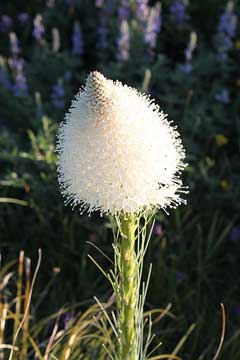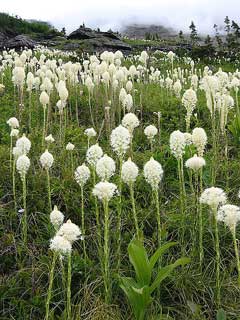 |
|
flickr.com/photo/60417851@N00/3738949755 |
 |
| PD-USGov-NPS |
Translate this page:
Summary
Physical Characteristics

 Xerophyllum tenax is an evergreen Perennial growing to 1.2 m (4ft) by 2 m (6ft 7in) at a slow rate.
Xerophyllum tenax is an evergreen Perennial growing to 1.2 m (4ft) by 2 m (6ft 7in) at a slow rate.
See above for USDA hardiness. It is hardy to UK zone 5. It is in leaf all year, in flower from July to August. The species is hermaphrodite (has both male and female organs) and is pollinated by Insects.
Suitable for: light (sandy) and medium (loamy) soils and prefers well-drained soil. Suitable pH: mildly acid, neutral and basic (mildly alkaline) soils. It can grow in semi-shade (light woodland) or no shade. It prefers moist soil.
UK Hardiness Map
US Hardiness Map
Synonyms
X. douglasii. Helonias tenax.
Plant Habitats
Woodland Garden Sunny Edge; Dappled Shade;
Edible Uses
Edible Parts: Root
Edible Uses:
Root - baked[92].
References More on Edible Uses
Medicinal Uses
Plants For A Future can not take any responsibility for any adverse effects from the use of plants. Always seek advice from a professional before using a plant medicinally.
Ophthalmic Styptic
The roots are styptic[257]. A poultice of the chewed root has been applied to wounds[257]. A decoction of the grated root has been used as a wash on bleeding wounds, sprains and broken limbs[257]. The washed roots have been rubbed to make a lather and then used to wash sore eyes[257].
References More on Medicinal Uses
The Bookshop: Edible Plant Books
Our Latest books on Perennial Plants For Food Forests and Permaculture Gardens in paperback or digital formats.

Edible Tropical Plants
Food Forest Plants for Hotter Conditions: 250+ Plants For Tropical Food Forests & Permaculture Gardens.
More

Edible Temperate Plants
Plants for Your Food Forest: 500 Plants for Temperate Food Forests & Permaculture Gardens.
More

More Books
PFAF have eight books available in paperback and digital formats. Browse the shop for more information.
Shop Now
Other Uses
Basketry Fibre Weaving
A watertight basket can be made from the leaves[21, 46, 61, 99, 257]. This basket has been used for cooking food in[257]. The fibres are split from the leaves and then used[92]. The plant is also used to decorate baskets[257]. The small leaves have been used to make dresses[257]. The plants were burnt every year. The leaves were harvested in the spring when they first started to grow out of the charred rhizome. Prior to using, the leaves were soaked in water to make them pliable, but if left too long they turned green[257]. The dried and bleached leaves are used for weaving into hats and capes[207, 257].
Special Uses
References More on Other Uses
Cultivation details
Requires a well-drained soil in full sun[187]. Prefers a fairly moisture-retentive sandy peaty soil[1, 200]. Requires a damp peaty soil[233]. Plants can be difficult to cultivate[188]. Plants are hardy to about -20°c[187], especially if the roots are given a good mulch in the winter[200]. If left undisturbed, plants can form quite large colonies, spreading by means of their tough rhizomes[200]. Plants do not flower every year, there are often gaps of 5 - 7 years between flowering[212].
References Carbon Farming Information and Carbon Sequestration Information
Temperature Converter
Type a value in the Celsius field to convert the value to Fahrenheit:
Fahrenheit:
The PFAF Bookshop
Plants For A Future have a number of books available in paperback and digital form. Book titles include Edible Plants, Edible Perennials, Edible Trees,Edible Shrubs, Woodland Gardening, and Temperate Food Forest Plants. Our new book is Food Forest Plants For Hotter Conditions (Tropical and Sub-Tropical).
Shop Now
Plant Propagation
Seed - we have no information for this species but suggest sowing the seed in a cold frame as soon as it is ripe if possible, otherwise in early spring. When they are large enough to handle, prick the seedlings out into individual pots and grow them on in the greenhouse for at least their first winter. Plant them out into their permanent positions in late spring or early summer, after the last expected frosts. Division as the plant comes into growth in the spring.
Other Names
If available other names are mentioned here
Native Range
NORTHERN AMERICA: Canada (Alberta (southwest), British Columbia (southeast)), United States (Idaho, Montana, Oregon, Washington, Wyoming, California (north))
Weed Potential
Right plant wrong place. We are currently updating this section.
Please note that a plant may be invasive in one area but may not in your area so it's worth checking.
Conservation Status
IUCN Red List of Threatened Plants Status :

Growth: S = slow M = medium F = fast. Soil: L = light (sandy) M = medium H = heavy (clay). pH: A = acid N = neutral B = basic (alkaline). Shade: F = full shade S = semi-shade N = no shade. Moisture: D = dry M = Moist We = wet Wa = water.
Now available:
Food Forest Plants for Mediterranean Conditions
350+ Perennial Plants For Mediterranean and Drier Food Forests and Permaculture Gardens.
[Paperback and eBook]
This is the third in Plants For A Future's series of plant guides for food forests tailored to
specific climate zones. Following volumes on temperate and tropical ecosystems, this book focuses
on species suited to Mediterranean conditions—regions with hot, dry summers and cool, wet winters,
often facing the added challenge of climate change.
Read More
Expert comment
Author
(Purs.)Nutt.
Botanical References
60200
Links / References
For a list of references used on this page please go here
Readers comment
© 2010, Plants For A Future. Plants For A Future is a charitable company limited by guarantee, registered in England and Wales. Charity No. 1057719, Company No. 3204567.